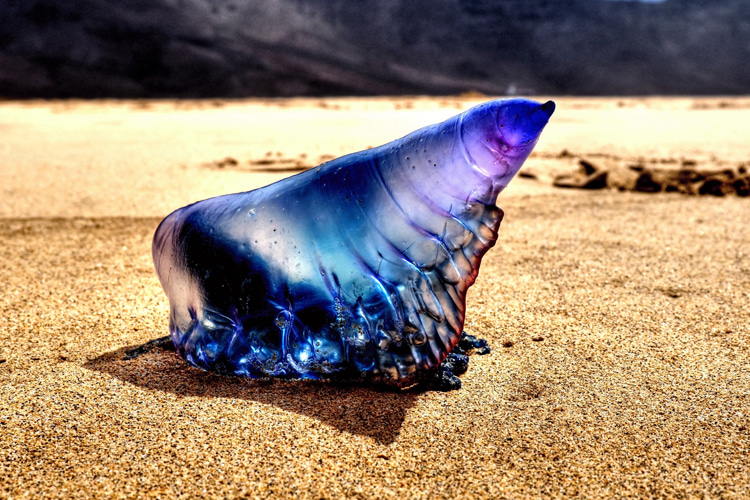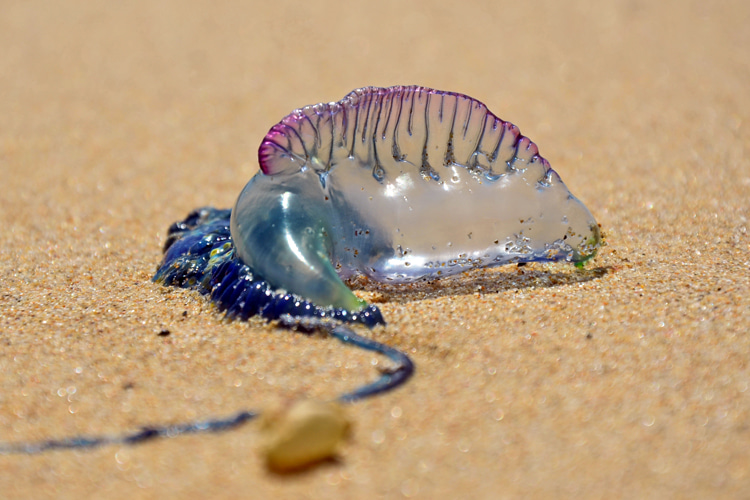Do you think you've been stung by the Portuguese man-of-war? The following guide will help identify a sting and take appropriate action.
Picture a balloon-like creature, bright and blue, bobbing gently on the waves. It may seem enchantingly beautiful, but don't be fooled by appearances.
This creature is none other than the Portuguese man-of-war - or man o' war - a fascinating marine hydrozoan that packs quite a sting.
Scientifically known as Physalia physalis, it is not a single organism but a complex colony of polyps that function together.
This fascinating critter gets its intriguing name from the 15th-century sailing ship it resembles, specifically a man-of-war (in Portuguese, "caravela").
This vessel was part of the Portuguese naval fleet during the Age of Discovery when the Southwestern Europeans explored and colonized all corners of the globe.

Navigating in Warm Waters
Physiologically, it's like a tiny, bustling city, with polyps specializing in tasks such as capturing prey, digestion, and reproduction.
The gas-filled bladder, or "pneumatophore," can be up to 12 inches (around 30 centimeters) in length and rises above the water surface.
At the same time, its tentacles, armed with venomous cells, trail underneath for up to 100 feet (about 30 meters).
As for where one might encounter these creatures, they have a wide distribution, mainly in warm oceanic waters.
You'll find them from the Pacific to the Atlantic, the Indian Ocean, and even the North Sea on occasion.
The carnivore Portuguese man o' war has a unique lifecycle.
Each individual starts from a single fertilized egg, which develops into a tiny polyp.
As the polyp grows, it begins budding off other polyps that serve different functions, forming a well-organized colony.

Understanding the Venom and Potency
The danger lies in the tentacles of the Portuguese man-of-war, where thousands of specialized cells called cnidocytes can be found.
These cells hold tiny harpoon-like structures filled with venom. When triggered by physical contact, they launch into the skin, releasing a potent cocktail of toxins.
This venom primarily contains proteins and peptides that break down cells, disrupt nerve signals, and affect the heart.
It's no understatement to say that the Portuguese man o' war's sting is not just a mere inconvenience - it's a veritable chemical warfare.
Although not necessarily deadly, the venom could be fatal to young children if it is not removed quickly.
Identifying a Sting: Signs and Symptoms
Ever heard the saying, "No pain, no gain?" In the case of a man-of-war sting, it's more like "much pain, no gain."
If you've been stung, you'll know pretty quickly. Symptoms typically start immediately and include:
- A sharp, stinging, or burning pain;
- Red, string-like lash marks that may blister;
- Swelling and redness around the affected area;
- Other possible symptoms include nausea, headaches, muscle weakness, heart symptoms, or even difficulty breathing in severe cases;
Portuguese Man-of-War Sting Treatment 101
Should you or another individual have the misfortune of being stung by a Portuguese man o' war, the following steps should be taken:
- Safety First: Ensure you are safely out of the water to prevent further stings or drowning if a severe reaction occurs;
- Remove Any Visible Tentacles: Using tweezers (never bare hands), gently remove any tentacles still attached to the skin;
- Rinse the Area: Contrary to some advice, recent research suggests using vinegar to rinse the sting site may worsen the pain. Instead, rinse with seawater or hot water (at a temperature you can comfortably tolerate) for about 20 minutes to help deactivate the remaining toxins;
- Heat Application: After rinsing, apply a hot pack or a towel soaked in hot water for further pain relief;
- Pain Relief and Medical Help: Over-the-counter pain relievers can help with discomfort. Seek immediate medical attention if severe reactions occur, such as difficulty breathing, chest pain, or if the sting covers a large area;
Pain and Duration
The pain from a Portuguese man-of-war sting can be pretty intense initially but typically starts to fade after about 1 to 3 hours.
The red marks may last a few days up to a few weeks. Persistent pain or skin reactions warrant a visit to your healthcare provider.
